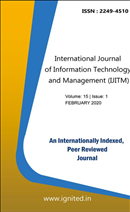A Study on Effectiveness of Social Media Advertisements on Consumers' Online Buying Intentions
Main Article Content
Authors
Abstract
The effectiveness of buying consumer intentions in social media advertisements, Consumersattitudes regarding social media advertising, their desire to participate in eWOM activities, their intent tovisit company websites, and their purchase intents are all intertwined in this study's suggested model,which is based on TAM theory and evaluated using CFA and SEM. According to a research, consumers'attitudes regarding social media advertising have a major influence on their intentions to engage ineWOM, visit company websites, and purchase products and services. Purchase intentions are stronglyinfluenced by both the desire to participate in online word-of-mouth marketing (eWOM) and the desire togo to the websites of certain firms. Gender has been discovered to play a major role in the relationshipbetween consumers' attitudes regarding social media advertising and their intentions to engage ineWOM behaviors and to visit the websites of firms to make purchases. Age does not appear to have arole in the relationship between consumers' attitudes regarding social media advertising and theirintents to visit the websites of firms.
Downloads
Download data is not yet available.
Article Details
Section
Articles
References
- Taylor, S. A., & Hunter, G. L. (2002). The impact of loyalty with e-CRM software and e-services. International Journal of Service Industry Management, 13 (5), 452- 478. doi:10.1108/09564230210447931
- Wolin, L., Korgaonkar, P., & Laud, D. (2002). Beliefs, attitudes and behaviour towards web advertising. International Journal of Advertising, 21 (1), 87-113. doi:10.1080/026 50487.2002.11104918
- Keller, K. L., & Lehmann, D. (2003). How do brands create value? Marketing Management, 5, 27-31. doi:10.12691/jbms-6-2-5
- Berens, G., & Yan Riel, C. (2004). Corporate associations in the academic literature: three main streams of thought in the reputation measurement literature. Corporate Reputation Review, 7 (2), 161-178. doi:10.1057/palgrave.crr.1540218
- Heijden, H. V. D., Verhagen, T. (2004). Online store image: conceptual foundations and empirical measurement. Information & Management, 41 (5), 609-617. doi:10.1016/j.im.2003.07.001
- Akar, E., & Topçu, B. (2011). An examination of the factors influencing consumers' attitudes toward social media marketing. Journal of I nternet Commerce, 10(1), 35-67.
- Abzari. M, Ghassemi. R. A., &Vosta. L. N. (2014). Analysing the effect of social media on brand attitude and purchase intention: the case of Iran Khodro Company. Social and Behavioral Sciences, 143, 822-826. doi:10.2501%2FIJMR-2015-018
- Kim, J., Naylor, G., Sivadas, E., & Sugumaran, V. (2015). The unrealized value of incentivized eWOM. Marketing Letters, 27(03), 411-421.
- Pongjit, C., & Beise-Zee, R. (2015). The effects of word-of-mouth incentivization on consumer brand attitude. Journal of Product & Brand Management, 24(07), 720-735.
- Bianchi, C., & Andrews, L. (2015). Investigating marketing managers' perspectives on social media in Chile. Journal of Business Research, 68(12), 2552-2559.
- Tercia, C. Y., & Teichert, T. (2016). Cultural context in word-of-mouth activity: How consumers respond to monetary incentives in WOM. Asia Pacific Journal of marketing and Logistics, 28(05), 827-840.
- Sen, S., & Lerman, D. (2017). Why are you telling me this? An examination into negative consumer reviews on the web. Journal of interactive marketing, 21(4), 76-94.
- Smith, T. (2017). The trends to watch in 2017. Retrieved April 28, 2018 from https://cdn2.hubspot.net/hubfs/304927/Downloads/Trends-17.pdf
- Duffet, R. G. (2015). Facebook advertising’s influences on intention-to-purchase and purchase amongst Millennials. Internet Research. 25 (4), 498-526. doi:10.1108/IntR-01-2014-0020
- Chaffey, D. (March 28, 2018). Global social media research summary 2018. Retrieved April 27, 2018 from https://www.smartinsights.com/social-mediamarketing/social-media-strategy/new-global-social-media-research/

